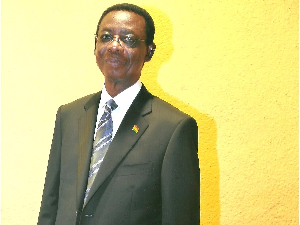The National Identification Authority (NIA) says it is poised to move on with Public-Private Partnerships (PPPs) in order to effectively deliver on its mandate.
According to the Authority, the PPP has become critical because, for the first time in its existence, the NIA is being required to rely almost entirely on its internally generated funds (IGF) to fund its operations.
This means that the Authority has no choice but to aggressively pursue its revenue sources and enter into creative partnerships under the law for the purpose of advancing its mandate.
Executive Secretary of NIA, Dr Josiah Mills Cobbah said it was important for NIA to take advantage of the “burgeoning PPP regime in Ghana, which has become a government policy, to partner with private sector firms to achieve the mandate.”
“We at NIA are committed to positively turning the fortunes of the Authority around in the shortest possible time,” he said.
He explained that the PPP arrangement has the potential to generate enough revenue to fund the operations of NIA to position the country to tackle terrorism, ghost names and SIM box fraud, to name a few of the many ills that confront Ghana.
In his words, NIA’s first PPP project has been largely successful.
He explained that foreigners’ registration under the name Foreigners Identification Management Systems (FIMS) project is an instant issuance system that eliminates the cost and challenges associated with card distribution.
According to him, the system also takes care of the data needs of all stakeholders, including all 10 fingerprints, an ICAO compliant portrait and contact information just to mention a few.
It has brought revenue to the NIA in an unprecedented way, he said.
Dr Cobbah stated that the NIA is currently engaging the private partner in a review of the FIMS contract by addressing various concerns that have been raised by the parties and stakeholders on issues such as revenue sharing, the nature of license fees, security, verification and the enforcement of card usage.
He explained that the goal of the process is to address all concerns taking advantage of all the lessons learned over the life of the project. He noted that the advantages of instant card issuance should be clear by now in the light of issues already mentioned, adding, “Suffice it to say that it is cost-effective.”
Dr Cobbah announced that the PPP Approval Committee (PPAC) has given approval in principle for an expanded PPP and is awaiting the submission of stakeholders’ report and a draft contract by the parties.
Following concerns raised in the media about the operations of NIA, the Authority is carrying out stakeholder engagements regarding its future plans.
The NIA Executive Secretary stated that these engagements began in 2014 after a Governing Board retreat, with NIA’s own staff who have largely been idle in view of the Authority’s lack of activity.
He said the anticipated new registration programme involves the instant issuance of Multifunctional Smart Identity Cards with a chip memory size of 148K.
He noted that the memory will be segmented and issued to various institutions to run their applications on the same card, instead of issuing multiple cards.
He explained that in order to make use of the old blank cards supplied to the NIA under the Morpho contract, a contact chip will be planted on the card through milling and embedding to convert the 2D barcode card into a contact smart card.
According to him, other cards being produced from scratch would be dual interfaced with both contact and Radio Frequency Identification (RFID) modes of communication.
A new biometric trait, the iris, has been added to enhance the security and integrity of the NIS. This will ensure that people with poor quality fingerprints can go through the process of identification and verification. Additionally, the Ghanacard has been designed to assist our compatriots with visual challenges to be able to use it using the tactile feature on the card.
The current Ghanacard is a 2D barcode card with only 1 kilobyte of storage (behind current required standards) with no verification infrastructure system in place. As already mentioned, the current NIS is designed for central issuance (not instant issuance), which leads to double operational cost. The current registration system has exceeded its five-year lifespan and it has to be replaced.
Operationally, the NIA has an obligation to ensure that at all times a technical and operational system is designed such that NIA remains firmly in control of its mandate, and that issues such as the determination of citizenship, the privacy of citizens and the security of data conform strictly to the requirements of the NIA enabling legislation.
Dr Cobbah expressed the hope that it would be able to receive all the necessary approvals for it to undertake a 12-month registration programme to register 15 million Ghanaians 15 years and above.
“We are also actively talking to other potential partners toward the registration of citizens below 15 years old,” he said.
Background
After about eight years of NIA’s involvement in a national registration exercise, the situation on the ground does not show a successful programme. NIA has:
1. Unprocessed data including data collected as far back as 2008 when the exercise began in the Central Region;
2. Experienced a very high data rejection rate in the region of 45%-50%;
3. Millions of Ghanacards printed but have not been collected due mainly to little or no funding;
4. Obsolete equipment including MRWs that were breaking down frequently;
5. Huge indebtedness, including sums owed to data collectors, contract staff, service providers, and huge utility bills;
6. A lot of idle labour including about 65 drivers, out of a staff strength of 180, who were hired for the intended nine-month registration exercise.
The negative impact of the system challenges on NIA’s ability to deliver on its mandate has been enormous.
Several explanations have been given by the technical staff for this situation. For example, whilst the system was not yet ready, data collection had started in earnest in 2008.
Indeed, it was only in November 2010 that system installation and training was completed, almost three years after commencement of data collection.
Technical difficulties that plagued the system included a software malfunction in the form of a script that behaved like a worm.
This script kept interrupting the system, took up memory space, and made the system generally unstable.
Looking at our operations in hindsight, it will be fair to conclude that a combination of system difficulties and operational problems, including inadequate funding, resulted in the failure of NIA to achieve the goal of registering 15 million citizens within a reasonable amount of time.
At this point, the exercise has been largely unsuccessful. To go back to correct mistakes and reregister Ghanaians using the old Morpho system is not a feasible option.
The technology in the identification industry has moved on, and what NIA was doing is now not compliant with international standards.
Achievements under Dr Cobbah
Over the years, the Authority had truly slipped into a distressed and dysfunctional state. Under the Governing Board’s direction:
i. We have dealt with all outstanding audit issues for the period 2011-2012 predating my appointment and are on course to finishing the 2013 audit;
ii. We are aggressively dealing with the factions and divisions that have developed over the years within the Authority. There is now a commitment to hold regular management staff meetings and staff durbars and to maintain a healthy positive relationship between management and the Governing Board.
iii. For the first time in the history of NIA, we shall meet the statutory requirement of submitting an annual report to parliament via our minister;
iv. We have achieved a reconstitution of NIA Entity Tender Committee in line with statutory requirements, which was not the case previously;
v. We have introduced a biometric literacy programme for all staff of NIA;
vi. We have drafted the NIA Policy Document/ecosystem setting out our corporate architecture and processes which our Board will be validating;
vii. We have reactivated the Annual Board retreat to review NIA situation with Board and others including management members. Last retreat before this was reactivated was in 2010;
viii. We are engaging an internationally recognised firm to help us with corporate restructuring and rebranding, strategic planning and organisational renewal using the funding from the World Bank;
ix. We have a submitted a draft NIA Bill for the Governing Board’s consideration with the goal of achieving an amendment of the current Act as soon as possible;
x. We have begun serious discussions with the Births and Deaths Registry to strengthen our collaboration as required by law, including co-location, ensure the necessary linkage that must exist between these two key organisations.
xi. With the help of the Presidency and the Ministry of Communication, a moratorium has been placed by the Chief of Staff on further purchases of AFISs by any MDAs; and we are engaging user agencies such as SSNIT and NHIS in discussions to bring about harmonisation and integration of public biometric databases.
xii. NIA’s Board and management are working hard to access a China Exim concessionary facility to enable the Authority to achieve nationwide presence and linkages with all our user agencies.
General News of Monday, 13 April 2015
Source: The Finder
NIA needs PPPs to survive - Dr Cobbah
Entertainment












